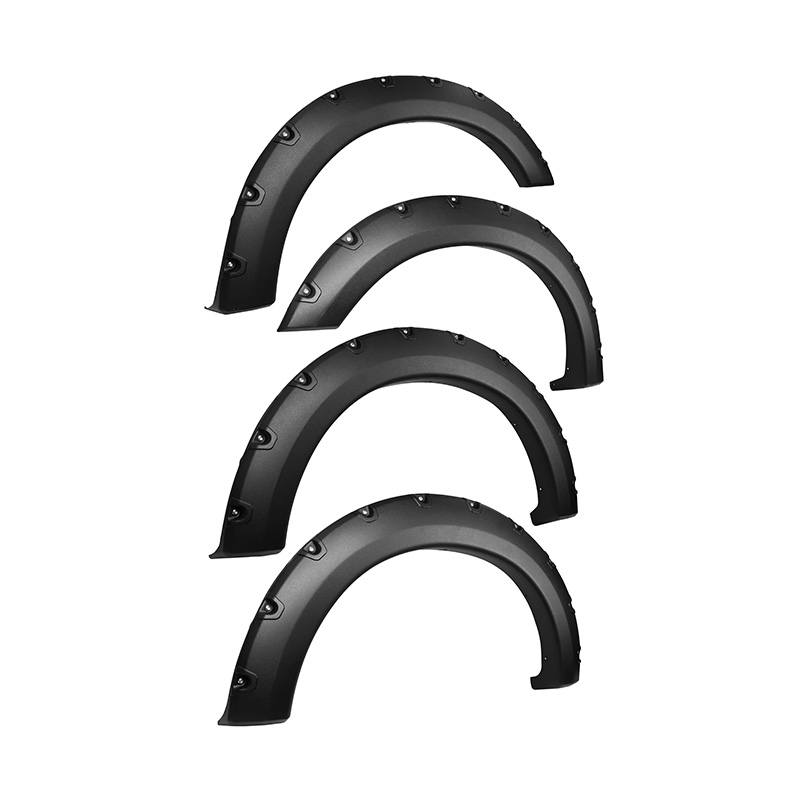2024-12-12
Whether or not fender flares can withstand extreme temperatures, strong sunlight, or rain and snow depends on their material, finish, and design. High-quality fender flares are usually more weather-resistant and can handle a variety of climate conditions, but weather resistance varies greatly from material to material. Here is a detailed analysis of how fender flares perform in these extreme weather conditions:
When fender flares are exposed to high temperatures (such as hot summer days or long periods of sunlight), if they are made of high-quality plastics (such as ABS plastics, polyvinyl chloride PVC, etc.), they can usually withstand higher temperatures without deformation or fading. High-quality fender flares usually have good heat resistance and can maintain stable physical properties to avoid softening and deformation caused by excessive temperatures. However, low-quality or unsuitable materials for high-temperature environments may cause fender flares to deform or fade in high temperatures.
In the cold winter, fender flares need to withstand the challenges of low temperatures. High-quality fender flares usually withstand cold weather and remain tough and not easy to crack or break. For extreme low temperature performance, some materials (such as ABS plastic) are guaranteed to be used in the range of -40°C to +80°C without brittle cracking due to low temperatures. However, if the material is not up to standard, low temperatures may cause fender flares to become brittle and easy to crack.
The ultraviolet rays in strong sunlight will affect many materials, causing them to age, fade or become brittle. High-quality fender flares are usually treated with ultraviolet (UV) protection, which can effectively resist the damage of ultraviolet rays and reduce fading and aging. This UV-resistant coating can increase the durability of fender flares, allowing them to maintain bright colors and good appearance after long-term exposure to sunlight.
Some fender flares use special UV protective coatings or surface treatments (such as UV-resistant coatings, carbon fiber texture surfaces, etc.) to effectively delay fading and material aging caused by ultraviolet rays.

High-quality fender flares are usually well waterproof and can effectively prevent water penetration even in frequent rain and snow weather. Most modern fender flares are waterproof and have a smooth surface that is not easy to absorb moisture and dirt. Rain and snow water can be easily guided away by the design on the fender flares, reducing the impact of accumulated water and mud on the vehicle.
If the vehicle is often driven in snowy or wet conditions, the corrosion resistance of fender flares is particularly important. Especially in areas where saltwater erosion is more serious (such as winter road salting), corrosion-resistant fender flares can prevent corrosion caused by the erosion of chemicals (such as salt) on the material. Generally, plastic, ABS and materials with good coating treatment can effectively resist these external influences.
In some areas with frequent sandstorms, fender flares can help reduce excessive sand and dust on the body and reduce the frequency of car washing. However, if the material used is inferior, the surface may be scratched or worn after long-term exposure to sand and dust.
In humid environments, especially near coastlines, fender flares need to have good rust and moisture resistance. High-quality plastic or specially treated metal fender flares can effectively prevent corrosion and damage caused by moisture.
How well Fender Flares stand up to extreme temperatures, strong sunlight, rain and snow depends on the material and finish they are made of. High-quality fender flares are usually better able to withstand these extreme environments, with multiple properties such as UV protection, high temperature resistance, low temperature resistance, moisture resistance, and corrosion resistance. If your area is often subject to these extreme weather conditions, it is recommended to choose high-quality fender flares with UV protection, temperature change resistance, and corrosion resistance to ensure long-term durability and beauty.